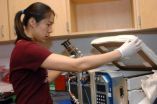(Press-News.org) After an 88-year-long hiatus North America's tallest bird, the statuesque whooping crane (Grus americana), is once again on exhibit at the Bird House at the Smithsonian's National Zoological Park. An 11-year-old male whooping crane named Rocky left Homosassa Springs State Park in Florida and is now on exhibit in the nation's capital. Whooping cranes are one of only two crane species native to the United States. There are only eight other zoos in the U.S. which exhibit these birds.
"It is an honor for the National Zoo to once again exhibit this magnificent species," said Dennis Kelly, director of the Smithsonian's National Zoological Park. "Although most people have heard of whooping cranes, very few have had the privilege of seeing one in person. We are thrilled to have Rocky here as an ambassador for his species."
Rocky is only the fourth whooping crane to call the National Zoo home. The Zoo's first crane, a wild-caught bird of unknown sex, arrived in 1897. Its last, a female, died in 1923.
By 1938, hunting and agricultural expansion had decimated wild whooping crane populations to an estimated 21 individuals. Zoos, research centers and nature preserves acted quickly to curtail the threat of extinction. Working together, they carefully matched individual birds that did not have mates in order to stabilize populations and achieve the greatest genetic
diversity possible—a considerable challenge, given the population bottleneck.
Today, U.S. whooping crane populations are managed by the U.S. Fish and Wildlife Service. According to the 2010 census, 407 whooping cranes reside in breeding centers and protected nature reserves in the eastern and mid-western United States and Canada, while another 167 individuals are in human care. These numbers mean that their population trends are increasing, an encouraging sign that the species will thrive.
"Their remarkable population recovery and subsequent reintroduction is one of the greatest conservation stories in North America," said Ed Bronikowski, senior curator at the National Zoo. "Thanks to the continuing efforts of many, this species is not going extinct anytime soon."
Despite this progress, whooping cranes are still considered endangered by the International Union for Conservation of Nature. In breeding centers and zoos, whooping cranes can live upwards of 40 years old. In protected nature reserves, however, a whooping crane's lifespan is limited to about 30 years. Collisions with fences and power lines, illegal hunting, predators, disease and polluted waterways threaten these cranes.
Visitors can see Rocky in the "Crane Run" exhibit outside of the Bird House. He is 5 feet tall and has a plume of white feathers, save for a patch of red and black feathers between his beak and the nape of his neck. He also has a 7-foot wingspan, which these cranes use to propel themselves 45 miles per hour during flight. Rocky will serve as an educational ambassador for his species, illustrating the behavior of whooping cranes to scientists, keepers and Zoo visitors. However, there is one trait visitors will not see Rocky perform: the loud "whoop" call these birds are named for.
"We don't know why Rocky is mute," says Sara Hallager, biologist at the Zoo's Bird House. "The reason behind his silence is a mystery known only to him."
The Zoo currently has no plans to breed Rocky, but his genes will not go to waste. He will participate in a study by the Zoo's Smithsonian Conservation Biology Institute that determines the impact of genetic diversity on whooping crane sperm quality and fertility rate in captivity.
INFORMATION:
National Zoo Welcomes Whooping Crane
2011-07-07
ELSE PRESS RELEASES FROM THIS DATE:
Twin study shows lifestyle, diet can significantly influence course of macular degeneration
2011-07-07
BOSTON -- Eating a diet high in vitamin D, as well as the nutrients betaine and methionine, might help reduce the risk of macular degeneration, according to new research conducted by Tufts Medical Center scientists. Their study of identical twins from the US World War II Twin Registry also found that the more a person smoked, the higher their risk of developing macular degeneration. The study, "Smoking, Dietary Betaine, Methionine, and Vitamin D in Monozygotic Twins with Discordant Macular Degeneration: Epigenetic Implications" published in the journal Ophthalmology on ...
Researchers engineer functioning small intestine in laboratory experiments
2011-07-07
LOS ANGELES (July 5, 2011) – Researchers at The Saban Research Institute of Children's Hospital Los Angeles have successfully created a tissue-engineered small intestine in mice that replicates the intestinal structures of natural intestine—a necessary first step toward someday applying this regenerative medicine technique to humans.
The study led by Tracy C. Grikscheit, MD —"A Multicellular Approach Forms a Significant Amount of Tissue-Engineered Small Intestine in the Mouse"— has been published in the July issue of Tissue Engineering Part A, a premier biomedical journal. ...
Final space shuttle to carry 5 CU-Boulder-built payloads
2011-07-07
The University of Colorado Boulder is involved with five different space science payloads ranging from antibody tests that may lead to new bone-loss treatments to an experiment to improve vaccine effectiveness for combating salmonella when Atlantis thunders skyward July 8 on the last of NASA's 135 space shuttle missions.
One experiment, sponsored by the global pharmaceutical companies Amgen and UCB, will test an antibody to sclerostin -- a protein that has a negative effect on bone formation, mass and strength -- on lab mice flying on the shuttle. Researchers on the project ...
Eggs may help prevent heart disease and cancer
2011-07-07
One of nature's most perfect foods may be even better for us than previously thought.
While eggs are well known to be an excellent source of proteins, lipids, vitamins and minerals, researchers at the University of Alberta recently discovered they also contain antioxidant properties, which helps in the prevention of cardiovascular disease and cancer.
Jianping Wu, Andreas Schieber and graduate students Chamila Nimalaratne and Daise Lopes-Lutz of the U of A Department of Agricultural Food and Nutritional Science examined egg yolks produced by hens fed typical diets of ...
Self-paced walking test useful for evaluating progress in lifestyle intervention programs
2011-07-07
HOUSTON- (July 5, 2011) - The self-paced walking test, known as the 400-meter walk test, is effective in measuring improved physical function in postmenopausal women who have lost weight through healthy physical activity and dietary changes, according to collaborative research conducted by The University of Texas Health Science Center at Houston (UTHealth) and The University of Pittsburgh.
"The 400-meter self-paced walk test is a simple, cost-efficient and effective test clinicians or researchers can use to evaluate progress in a weight loss or physical activity program," ...
Being small has its advantages, if you are a leaf
2011-07-07
The size of leaves can vary by a factor of 1,000 across plant species, but until now, the reason why has remained a mystery. A new study by an international team of scientists led by UCLA life scientists goes a long way toward solving it.
In research federally funded by the National Science Foundation, the biologists found that smaller leaves are structurally and physiologically better adapted to dry soil because of their distinct vein systems.
The research will be published in an upcoming print issue of the journal Plant Physiology and is currently available in ...
USC researchers link genetic marker to rectal cancer treatment
2011-07-07
A team of researchers led by Keck School of Medicine of the University of Southern California (USC) oncologist Heinz-Josef Lenz, M.D., has identified a genetic marker that may predict which patients with rectal cancer can be cured by certain chemotherapies when combined with surgery. The discovery, scheduled for publication in the August 1 edition of Clinical Cancer Research, brings doctors closer to customizing cancer treatment to individual patients.
Lenz, professor of medicine and preventive medicine in the division of medical oncology at the Keck School and the study's ...
Old life capable of revealing new tricks after all
2011-07-07
Archaea are among the oldest known life-forms, but they are not well understood. It was only in the 1970s that these single-celled microorganisms were designated as a domain of life distinct from bacteria and multicellular organisms called eukaryotes.
Robert Gunsalus, a UCLA professor of microbiology, immunology and molecular genetics, developed an interest in Archaea because of their ability to thrive in harsh environments. Now, using state-of-the-art imaging equipment at the California NanoSystems Institute (CNSI) at UCLA, he has shown for the first time that a type ...
Ruminant headgear: A mystery awaiting unraveling
2011-07-07
EUGENE, Ore. -- Emerging from the heads of most cud-chewing mammals, headgear inspire an almost mystical and certainly majestic aura. But, scientists say, we know shockingly little about them.
In a paper appearing online ahead of regular publication in the Proceedings of the Royal Society B, a London-based international journal dedicated to biology, a three-member scientific team spells out what is known -- and not known -- about antlers, horns, pronghorns and ossicones.
For antlers, think deer, moose and elk. Horns are worn by cattle, sheep and goats; ossicones by ...
Gene therapy stimulates protein that blocks immune attack and prevents Type 1 diabetes in mice
2011-07-07
Increasing a specific protein in areas of the pancreas that produce insulin blocks the immune attack that causes type 1 diabetes, researchers reported in the August issue of the Journal of Clinical Investigation, published early online.
The discovery could lead to a drug that prevents the progression of type 1 diabetes in people newly diagnosed who are in the "honeymoon" phase of the disease, when the immune system has not yet destroyed all of the insulin-producing beta cells in the pancreas.
The finding could also lead to new drugs for overcoming organ rejection in ...



